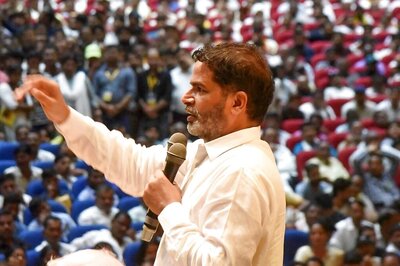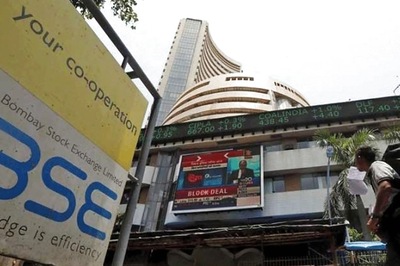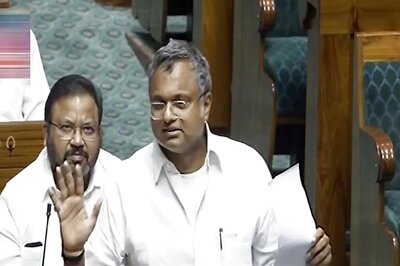
views
India became the first country to land a spacecraft near the moon’s south pole on Wednesday as the Chandrayaan-3 overcame numerous challenges before its historic touchdown on the lunar surface. In an exhaustive interview with CNN-News18, Indian Space Research Organisation (ISRO) chairman S Somanath spoke about the various challenges the mission could still encounter on the lunar surface, but added that “there is no fun if everything is known", while revealing plans about future projects. Edited excerpts:
After the successful soft landing, everyone wants to know the health of the lander and rover and if they have started the scientific experiments.
The rover and the lander are in good health. Both are working very well. Scientific experiments are yet to begin. We will take some more time.
You called the final phase of landing “15 minutes of terror". What were the emotions during that time? Any anxiousness? Many have called the landing a textbook precision landing.
It was supposed to be a textbook precision landing and there was nothing surprising for me. There was nothing anxious in that part because it was following the trajectory of what we designed. It was giving hope that it would land perfectly well. So I had no worries. There was no reason for it.
What are the challenges on the lunar surface from here on?
There are many issues on the lunar surface which we are experiencing for the first time. Especially when there are moving items, they can get entangled with the dust. It can get into moving parts and jam them. The bearing of the system may not work, the motor may not work and it can get stuck. The dust is a special dust, not like Earth dust. In the absence of atmospheric air, it can stick to materials. All this can create problems in the mechanism. We are yet to experience it. So let’s see how it goes. Temperature is another issue. We will face it as it goes. Sometimes we may face…sometimes it’s a new learning for us. We will wait for it. That’s why we are exploring. There is no fun if everything is known.
What happens to the large amount of data that will be collected? Will ISRO analyse first and then share it with other space agencies?
There is a separate mechanism for it. There is a separate committee looking into it. It will have investigators from each of the payloads and co-investigators, and collaborate. There is a big team behind every instrument. They will get all this data and they will make sense of it. They all are from the Indian scientific community. They will use this data first before we give it to anybody. Later it will be posted to our centralised archives which can be accessed by the entire world freely after a lock-in period. That lock-in period has to be decided.
What next in terms of future goals? People are talking about the possibility of bringing back samples from the moon.
We should do all of that one day. All of this is done to enhance our understanding and to demonstrate technological capabilities. Bringing samples from the moon is needed at some point in time when we have the ability to do that. Possibly we may have it very fast. Sometimes we may not do it also depending on the situation. We may be able to go there and do it ourselves instead of bringing it here. So it depends on the type of technology, money, and investment one can afford at that point in time. There are many more missions we need to do…not limited to the moon. We need to go to Mars, and Venus and we need to understand other planets. At some point, we have to go out of our solar system also, all this is needed. This is the first stepping stone in achieving that. For our generation, this is the step. For the next generation, there will be bigger steps.
Why did ISRO pick the south pole region? Is it only because it is an unexplored region or are there other reasons?
As far as I know, the south pole has less sun heat and light, so there are possibilities and scientific interest is very high. It is hypothesised by various scientists known to moon science that there could be larger deposits of water beneath the surface. Of course, that’s not the objective of this science mission. But there are other mineralogical observations that will be different from the equatorial region. Landing there itself is a challenge. So we would’ve liked to achieve it. And we achieved it as the first country to land near the south pole. That way, it marks scientific interest.
The Prime Minister has spoken about Mars and Venus. Have we completed a successful Mars Orbiter Mission? What are the priorities for ISRO from here on?
For priorities, we have a well-defined roadmap to do it. Starting with Aditya-L1, we will have missions on Ganganyaan…apart from regular launches of PSLV, GSLV, SSLV, and LVM3, all of them in the offing. NISAR is getting updated for the beginning of next year.
What is the status of the Ganganyaan project?
Ganganyaan is going fine. We have completed the human rating on GSLV Mk 3. We have developed a crew module and crew escape system. It has to be tested and it has to go through qualifications. Test flights we do is one of the major tests. 6-7 tests have to be done before we send a man to space.
You mentioned the passing of knowledge from one generation to another. Where do you place Chandrayaan in India’s space journey and inspire younger generations?
Chandrayaan 3 is a milestone in the history of the space programme of this country. Many have attempted to soft-land on the moon and have not succeeded. It marks a technological transition point. It’s also a transition point in the view of the policy. We have a space policy 2023 announced. So both are coinciding in 2023. It’s a watershed year and the space sector is going through a transformation technologically, scientifically, and in terms of building ecosystems. Whether it’s PPP or private space companies coming up, this will also boom.
Apart from the soft landing, instruments like LDV and hazard detection and avoidance cameras have been developed in-house. Many say that’s also a major demonstration of technological capabilities
Instruments are not available for procurement easily and their cost is too much. Our labs have developed those systems: the camera-based systems and laser-based systems. We have capabilities. It’s a technological backup we are working on for satellite and launch vehicles. We are happy about that part.
Many experts believe that the soft landing will enhance ISRO’s commercial space market share to a double-digit percentage. What is your assessment?
We have no interest in doing business. It has to be done by private entrepreneurs. So whatever we have developed and is commercially viable, we are transferring to industry, so that it can be taken up to generate revenue or business. ISRO will focus on R&D and technology development so that it will empower our capabilities. Chandrayaan is that part of the work, but operational systems and the economy are different areas. There is a path connecting this. If technology grows, business will also grow. It’s linked. Old technology cannot produce a new economy. New tech is needed to make a new economy, like 4G, 6G, and quantum communication.




















Comments
0 comment